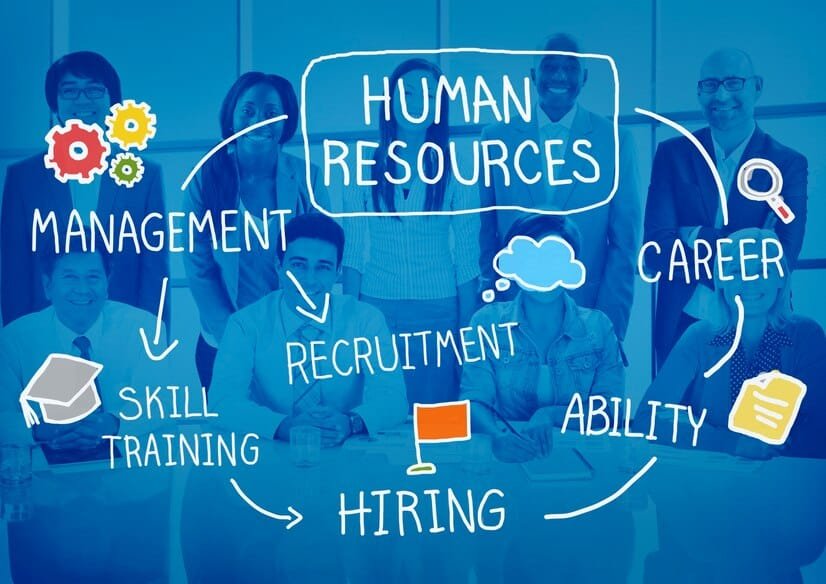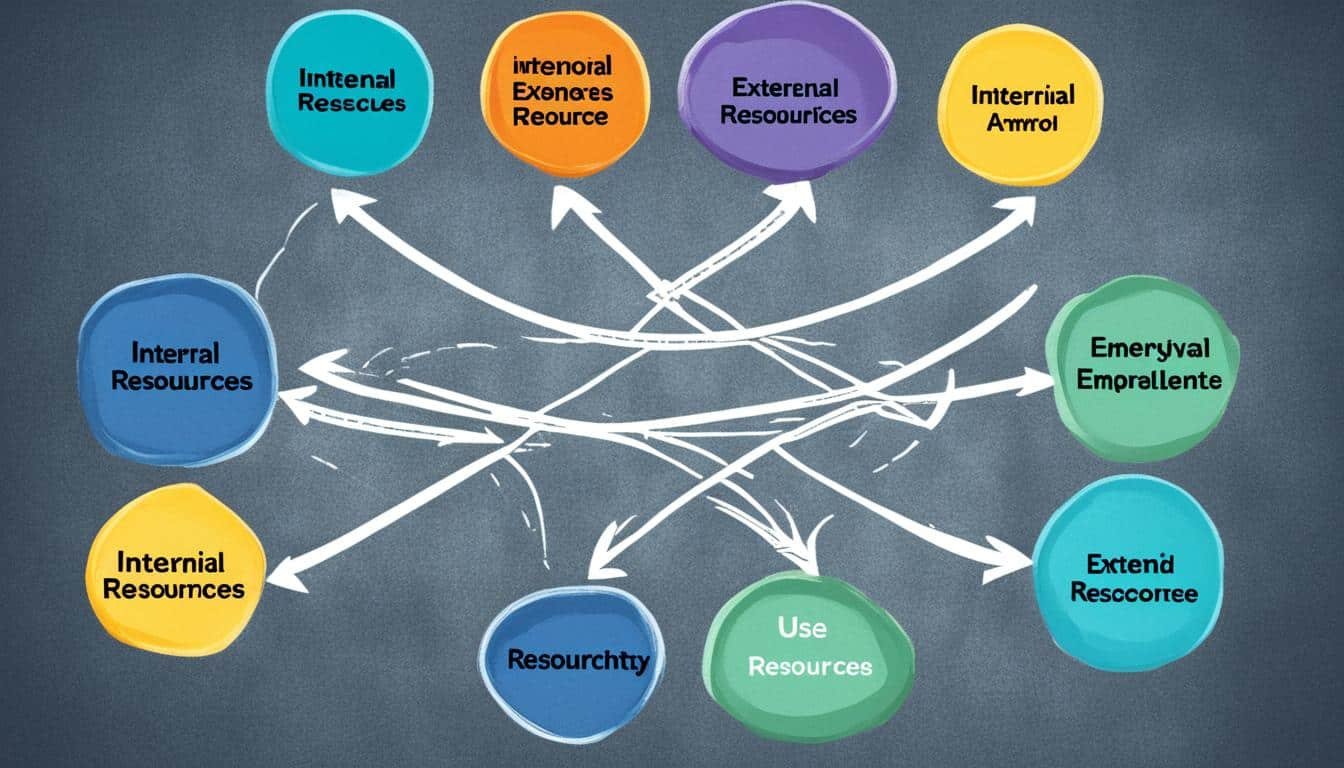Human resources (HR) is a key part of a business. It focuses on finding, training, and managing employees. HR aims to boost employee happiness, keep them around, and make them work better. This can change based on the company and job type.
HR helps companies deal with the fast-changing business world. It also meets the need for skilled workers in today’s world. By creating a good work culture and following labor laws, HR helps companies succeed.
Key Takeaways
- HR is responsible for managing a company’s most valuable asset: its employees.
- HR plays a crucial role in workforce planning, talent acquisition, and employee development.
- Effective HR practices can improve employee engagement, productivity, and retention.
- HR ensures compliance with labor laws and fosters a positive work environment.
- HR contributes to a company’s strategic goals and competitive advantage.
John R. Commons and the Origin of the Term
John R. Commons, an American economist, first used the term “human resources” in the early 1900s. He saw the workforce as a key asset, not just a cost. This idea is now a key part of HR management.
Understanding Human Resources (HR)
Human resources (HR) is the part of a company that finds, checks, and trains new employees. They handle things like compensation, benefits, and terminations. Human resource management (HRM) aims to make the workforce better to help the company grow.
Key Takeaways
- HR departments must keep up with laws that affect the company and its employees.
- Many companies use outside help for tasks like payroll and benefits.
John R. Commons and the Origin of the Term
John R. Commons, an American institutional economist, came up with the term “human resource” in 1893. By the 20th century, HR departments started to form, solving issues between employees and employers. Now, every business needs an HR department. Their main job is to make employees work better and keep the organization safe from problems with the workforce.
Key HR Activities
HR activities are key to boosting employee productivity and innovation. They help shape the work experience and drive business growth. HR pros manage things like pay, benefits, and make sure the company follows labor laws.
Some important HR tasks are:
- Effectively managing and using people to reach their full potential and help the company grow.
- Linking how well people do their jobs and what they earn, making sure it’s fair.
- Creating a list of benefits that keeps great employees happy and on board.
- Building skills that improve both personal and team performance, sparking new ideas.
- Making work processes more flexible to stay competitive and adaptable.
- Handling complex labor laws and checking compliance to keep things running smoothly.
By focusing on these key HR tasks, companies can build a culture of employee productivity, innovation, and flexibility. This leads to long-term success and growth.
“The most valuable asset of a 21st-century institution, whether business or non-business, will be its knowledge workers and their productivity.”
– Peter Drucker, Management Consultant and Author
Good HR practices, like managing talent, setting fair pay, and following the law, are key. They help unlock the full potential of an organization’s most valuable asset: its people.
human resources Management Strategies

In the 1980s, human resource management (HRM) became a key way to manage employees and shape a company’s culture. HRM is all about finding, managing, and guiding people to meet the company’s goals. HR teams now play a big role in making the workforce better and suggesting new ways to do things.
Google’s Approach to HRM
Google is a top example of using a forward-thinking HRM strategy. They offer many perks like mental health support, free meals, fitness centers, massages, and ergonomic chairs. Google thinks a happy and healthy team means more productivity.
Strategic human resource management started way back in the early 1900s. In 1901, National Cash Register Co., now NCR Corp., set up the first team to handle wages, safety, and employee issues. This was the start of modern HR.
“Happy employees are more productive employees.”
Google shows how strategic human resource management can really work. By focusing on their employees’ well-being, Google has seen big gains in employee relations, perks, and productivity. This has helped the company do well overall.
HR Outsourcing

In today’s fast-changing business world, many companies are turning to HR outsourcing. This approach helps manage operations better. By outsourcing some HR tasks, companies can free up their HR teams. They can then focus on important tasks that help the business grow.
Functions Commonly Outsourced
Companies often outsource these key HR tasks:
- Payroll administration: Making sure employees get paid right and on time, and handling taxes.
- Employee benefits: Managing health insurance, retirement plans, and other benefits for employees.
- Recruitment: Finding, checking, and welcoming new employees to help the company grow.
- Background checks: Checking the background and credentials of new employees to reduce risks.
- Exit interviews: Talking with employees who are leaving to learn what we can improve.
- Risk management: Spotting and fixing legal and compliance issues.
- Dispute resolution: Dealing with employee complaints and conflicts fairly.
- Safety inspection: Making sure the workplace is safe and healthy.
- Office policies: Creating and following company-wide rules and procedures.
Using recruitment software today can make HR departments work better. It lets them focus on big-picture tasks that help the business succeed.
“Outsourcing lets companies use their HR resources better. This way, they can focus on key business tasks and strategic plans that add value.”
What Is the Role of Human Resources?
Human resources (HR) is key to a business’s success. They handle many tasks to support the company and its workers. This includes hiring, keeping employees, and managing benefits to make sure the company runs smoothly.
HR’s main job is to recruit and hire the right people. They look through resumes, interview candidates, and make sure new hires fit in well. They also make sure new employees get the training they need.
HR also focuses on employee relations. They listen to employee concerns and work to make the workplace better. HR connects employees with management to make sure everyone’s needs are met.
Keeping employees happy is another big job for HR. They create and manage benefits programs to keep workers engaged. This includes health insurance, retirement plans, and chances for growth and rest.
HR also makes sure the company follows the law. They handle payroll, keep employee records, and follow all employment rules and policies.
In summary, HR supports the company by focusing on hiring, keeping, and managing employees. By doing this, HR helps create a great place to work that follows the law.
What Is Human Resource Management (HRM)?
Human resource management (HRM) is a way to make the most of a company’s workforce. It aims to improve the work culture and work environment so employees work well and efficiently. HRM uses metrics to check how well the workforce is doing.
HRM is all about managing a company’s human resources. It covers many tasks, like hiring and onboarding new staff, and training and developing them. It also shapes the company’s culture and work environment. This affects how well employees work and the success of the business.
Good human resource management needs a strategic and data-based approach. By using HR metrics and analytics, companies can make smart choices about their workforce. This helps improve the work culture to meet the company’s goals.
“HRM is the process of managing people in organizations in a structured and thorough manner. It includes the practices that affect the workforce, such as recruiting, screening, training, and appraising employees.”
Effective human resource management is crucial for a company’s success. It helps attract, develop, and keep a skilled and motivated workforce. This leads to better productivity and growth for the company.
Five Core Functions of Human Resources
The HR department is key in managing the employee lifecycle in an organization. It handles many tasks, but five main functions are crucial for effective HR management.
- Recruitment and Hiring: HR finds, attracts, and welcomes the right people for the job. This includes posting jobs, checking candidates, interviewing, and hiring.
- Compensation and Benefits: HR deals with employee pay and benefits. This includes salaries, bonuses, health insurance, retirement plans, and vacation time.
- Career Development: HR helps employees grow in their careers. They offer training, mentorship, and advice on career paths.
- Employee Relations: HR connects management with employees. They solve work issues, fix conflicts, and make sure the workplace is positive.
- Policy Development: HR creates and updates rules for the workplace. This includes employee handbooks, following the law, and workplace policies.
Handling these core HR functions well helps organizations have a happy, productive, and motivated team. This leads to success for the company.
“The true goal of human resources is to enable the organization to achieve its strategic objectives by attracting, developing, and retaining talented employees.”
The Importance of HR in Business
The HR department is key in managing the employee lifecycle. This includes recruitment, onboarding, training, and handling terminations or retirements. HR pros need to keep up with industry trends and laws to ensure the company follows the rules. This helps create a positive work environment that supports the company’s goals.
Employee Lifecycle Management
HR takes care of the whole employee lifecycle. This means:
- Recruitment and hiring
- Onboarding and training
- Employee development and career growth
- Performance management
- Compensation and benefits administration
- Termination or retirement
By handling the employee lifecycle, HR ensures a productive, engaged, and happy workforce. This is key for business success.
Compliance and Industry Trends
HR also keeps up with labor laws, regulations, and industry best practices. This helps them keep the company legal and supports a positive work environment. It also helps with productivity.
By knowing about industry trends and changes in laws, HR helps the business stay competitive. This ensures the company follows the rules and stays ahead.
“The role of HR in business is to ensure that the organization has the right people in the right places to achieve its strategic objectives.”
Internal vs External Human Resources

Managing your business’s human resources can be done in two ways: with an internal team or by outsourcing. The choice depends on your company’s size and needs employment opportunity.
For small businesses, outsourcing HR tasks like payroll and recruitment can save money. You get expert help without the cost of a full HR team. Yet, it’s key to keep some HR staff in-house to make sure the outsourced work fits your company’s rules and goals.
For larger companies, having a strong internal HR team is better. This lets them create specific HR plans, handle employee life cycles, and keep up with compliance. It costs more but gives more control and personalization for your company’s needs.
| Internal Human Resources | External Human Resources |
|---|---|
|
|
Choosing between internal and external HR depends on your business’s size, budget, and needs. By weighing the pros and cons, you can find the best mix of internal and external HR support for your company’s growth and success.
“Effective human resources management is a crucial component of any successful business, regardless of size or industry.”
Also Read : How Does Marketing For Business Plan Work?
Conclusion
Human capital is the most valuable asset in any organization. It’s crucial to treat it with great care and respect. Employers must build a strong human resources team to attract top talent and keep them happy. This team should help create a positive work environment and align the workforce with the company’s goals.
A well-managed HR department is key to an organization’s success. It ensures compliance and helps in attracting, developing, and keeping top talent. This is vital in today’s fast-paced business world.
Investing in human capital unlocks the full potential of a workforce. It leads to greater success for employers. The role of human resources is to support and empower employees to contribute to the company’s success.
By focusing on human resources, employers can create a workforce that is thriving, productive, and motivated. This leads to innovation, increased productivity, and business growth.
FAQs
Q: What is human resources and its role in a business?
A: Human resources (HR) is a department within a business that manages all aspects of employee resources, from recruitment and training to employee relations and benefits administration. HR plays a crucial role in creating a positive work environment and ensuring compliance with labor laws.
Q: What are the typical responsibilities of a human resources manager?
A: HR managers oversee talent management, employee relations, training and development, payroll, and ensuring compliance with employment laws. They also play a key role in workforce planning and creating a positive work environment.
Q: What are the different types of human resources roles within a company?
A: The types of human resources roles include HR generalists, HR specialists (such as recruitment or labor relations), HR directors, and HR administrators. Each role focuses on different aspects of HR management within the organization.
Q: How does the human resources department add value to a company?
A: The HR department adds value to a company by recruiting and retaining top talent, fostering a positive work culture, ensuring compliance with labor laws, and providing training and development opportunities for employees.
Q: What job opportunities are available in the field of human resources?
A: Job opportunities in human resources range from HR assistants and coordinators to HR managers, directors, and specialists in areas such as recruitment, training, and benefits administration. A degree in human resources or business administration can open up various career paths in HR.
Q: How does human resources support the overall organizational goals of a business?
A: HR supports organizational goals by aligning HR strategies with business objectives, ensuring workforce planning to meet future needs, providing HR metrics and analytics for better decision-making, and developing policies that promote employee engagement and productivity.
Q: What is the role of human resources in managing employee resources effectively?
A: Human resources managers are responsible for overseeing employee resources, including recruiting, onboarding, training, performance management, and resolving workplace conflicts. They contribute to creating a positive work environment that fosters employee growth and satisfaction.




